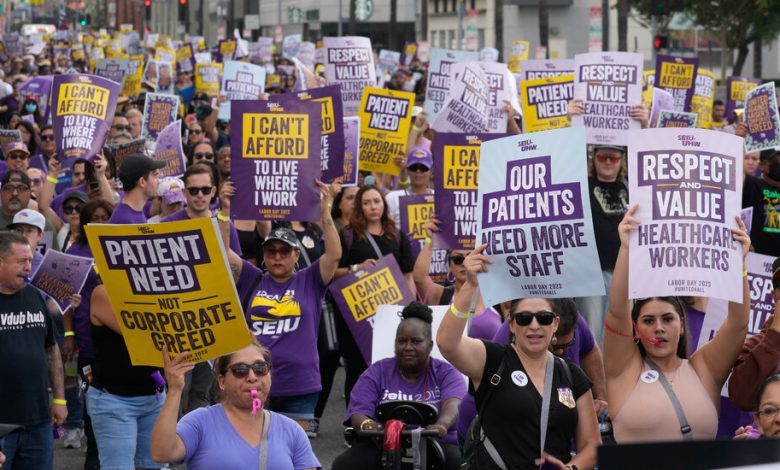Kaiser Permanente Workers Poised to Strike

More than 75,000 Kaiser Permanente employees are threatening to walk out Wednesday morning if they cannot agree to a new labor contract. The previous contract expired on Saturday. Union leaders say this could be the largest strike by health care workers in recent U.S. history.
Kaiser, a large nonprofit health system, provides care for 13 million people in eight states, including California, Colorado and Washington, and the District of Columbia. The job action would involve support and other staff, including X-ray and lab technicians; sanitation workers who disinfect rooms between patients; and pharmacy workers who help dispense medications. These workers attend surgeries, run imaging equipment and assist in outpatient clinics. Doctors and many nurses are not part of the strike, which is set to last three days in some places. Some nurses, therapists and aides could also walk out.
Kaiser said it was preparing for a possible strike and would do what it could to minimize any disruptions to patients. “Our hospitals are going to remain open,” including the emergency departments, said Michelle Gaskill-Hames, regional president for Kaiser Permanente in Southern California and Hawaii.
But patients could experience delays in getting appointments, or procedures that are not considered urgent could be postponed.
The strains of an acute staffing shortage have led union officials to warn that the strike is likely if Kaiser executives ignore their concerns. Workers say the lack of adequate staffing at Kaiser facilities is creating unsafe conditions for patients. The unions say that Kaiser needs better wages to attract workers and that it needs to hire enough people to make up for the exodus of staff during the pandemic.
“It’s so disappointing to see them falling down here,” said Caroline Lucas, the executive director of the Coalition of Kaiser Permanente Unions, the collection of a dozen unions that notified Kaiser last month about the possibility of a strike. The coalition represents about half of Kaiser’s unionized work force, largely in California, where Kaiser is based.
While the pandemic caused an immediate crisis in which workers were stretched too thin, Ms. Lucas said employees had been concerned about short staffing even before Covid hit. “For years, there has been a crisis on the horizon,” she said.
Negotiations are continuing through midday Tuesday. “We are committed to staying at the table as long as we need to,” Ms. Gaskill-Hames said.
She said Kaiser was grappling with the same staffing problems as other health systems across the country. The group has fared better than many of its competitors, she said, in limiting turnover and hiring replacement staff. “We have really ramped up on aggressive retention and recruitment strategies,” Ms. Lucas said.
The frustrations of health care workers, who feel they are being forced to care for too many patients for too little pay, have been boiling over across the country. Many of the workers who remain feel burned out and are struggling to handle a higher volume of patients. The concern over inadequate staffing resulted in a nurses’ strike in New York City in January, and there were more than a dozen similar strikes this year in California, Illinois, Michigan and elsewhere.
The tight labor market has emboldened many unionized workers, leading to the recently averted strike at United Parcel Service and current picket lines among autoworkers. “Unions are flexing their muscles in a bunch of industries,” said Ruth Milkman, a professor of sociology and labor studies at the City University of New York.
The pervasive short staffing in health care gives workers significant leverage to demand better working conditions and higher pay, she said.
Many nurses are represented by other unions, including the California Nurses Association, which agreed to a new contract in Northern California last December.
The high levels of burnout have exacerbated the staffing shortages, said Ethan Ruskin, a health educator at Kaiser Permanente in San Jose, Calif. Patients have to wait longer than usual for appointments, he said, only to face more delays in the waiting rooms.
“If they see something on your mammogram and send you for a sonogram, you’re going to be waiting weeks for a scan,” Mr. Ruskin said. “Meanwhile our sonographers have huge injury rates — things like stress fractures — because they are expected to see twice as many patients as they should.”
Mr. Ruskin, who works alongside doctors to educate patients about various diagnoses, such as diabetes, said employees in San Jose had been frustrated by their working conditions for more than three years. “The executives could stop the strike today, frankly,” Mr. Ruskin said. “To be clear, nobody wants to go out on strike. But we’re prepared to. We get into this field because we want to help people. We’re not sure what else to do at this point.”
Kaiser released a video and other resources in recent weeks to urge workers to push back on union calls for a strike. They argue that, in contrast to other high-profile labor negotiations, such as those among autoworkers and Hollywood actors, the effects of a health worker strike on the public would be immediate and life-threatening. The unions, however, have said that a strike is necessary to protect patient safety.
As the talks continue, the sides have yet to agree on a minimum hourly wage for workers and the rate of annual increases over the life of the four-year contract. The union wants a $25 hourly minimum wage and increases of 7 percent in the first two years and 6.25 percent in the two years afterward, according to its latest public proposal.
Kaiser has countered with minimum hourly wages of between $21 and $23 next year, increasing by a dollar a year. Raises would vary among locations, with workers in some places, like Northern California, receiving annual increases of 4 percent for four years, while some others would receive an increase of 3.5 percent the first year, followed by 3 percent annual increases.



